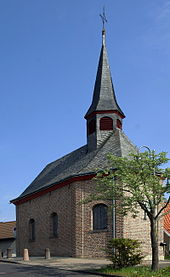St. Mary's Wedding (Oedekoven)
St. Mariä Vermählung is a Catholic chapel above the Church of St. Mariä Himmelfahrt in the district of Oedekoven in the municipality of Alfter in the Rhein-Sieg district of North Rhine-Westphalia .
It was built by the residents in 1756. At that time, the chapel was the only church in the Oedekoven community, which did not yet belong to the Alfter community, but was independent. Today in the chapel mainly meditative services take place as well as the annual Eucharistic celebration at the small fair on the third Saturday in January.
history
Since the abbess of the Burbach monastery provided the residents of Oedekoven with a plot of land to build a chapel in 1756 , the old town center on the corner of Ginggasse and Staffelsgasse has had a chapel made of field fire bricks by the residents . In 1757, immediately before the start of the grape harvest, it was consecrated to the patronage of The Seven Joys of Mary by the Bonn dean , later the name was changed to Mariä Marriage .
In this village chapel they met to Foundation fairs , communal rosary prayer and private prayer, while for regular church attendance in the Mother Church of St. Lawrence to Lessenich / Meßdorf had to go. That changed in 1940 when the priest Heinrich Flatten , who was on leave to continue his studies, came to Oedekoven.
Soon the chapel became too small for the rapidly growing population in Oedekoven; Even an extension of the organ gallery in 1947 did not bring any real relief. Old villagers say that at some church services, worshipers stood outside the door and joined in the celebrations. So the desire for a larger church of their own grew and so their own church of St. Mary of the Assumption was built nearby .
architecture
The chapel is a simple hall structure with a three-sided choir closure and a flat barrel 20 feet long (around six meters) and an interior width of around 13-14 feet (around four meters). Its current design is the result of extensive renovation work in the years 1968 to 1971 and 1981.
Reiter: In 1971 the chapel was reopened as a war memorial in the district of Oedekoven with a relief plate made of copper, which shows the four apocalyptic riders over Oedekoven and commemorates the dead of the two world wars. The riders represent the so-called messianic pangs of war, rising prices, famine and mass death .
Altar: On November 29, 1981, after further renovation work, the altar table was rededicated by Auxiliary Bishop Klaus Dick and relics of the two Bonn city patrons Cassius and Florentius were buried in the altar. In addition, the rococo altarpiece (late baroque) and the figures were restored. The altarpiece and the statue of Mary above the entrance did not come into this chapel until 1864 after the chapel at Tempelhof, where they were originally located, was destroyed in a fire. The altarpiece was originally designed in color. In the center is the picture of the Holy Family adoring the newborn child. Above it is the lamb lying on the book with the seven seals ( Rev 5–8 EU ). In the arch of the altarpiece is the Christ monogram " IHS " in a halo, often translated as "Jesus, Savior, Blessed" in the vernacular.
Figures: The two figures of saints standing on simple consoles to the right and left of the altar in the area of the choir closure are particularly striking. They are easily recognizable as Franciscans by their robes . Originally the figures were painted in color, but during a restoration in the early 1940s they were left in wood color. It is more difficult to name them as specific people. The attached attributes help here: While the left figure has placed its right foot on the head of a Turk, the right foot of the right figure is on a (world) sphere. The figure on the left is John of Capestrano (1386-1456), who was a gifted preacher and played a decisive role in the defense and victory over the Turks before Belgrade in July 1456. He was also a great pastor and peacemaker. The other figure is probably Francis of Assisi (1181–1226). Standing with the right foot on the globe is interpreted as contempt for the world or detachment from the world, just as Francis did.
Bell: The bell in the bell tower of the chapel is something special . Even if it seldom calls for services, it is a very old bell from the 14th century, as noted when the bell crown was renewed in 1956 has been.
Web links
Individual evidence
- ^ Gerhard Hoffs: Bells in the dean's office Bornheim. (No longer available online.) P. 29 , archived from the original on January 12, 2016 ; accessed on February 5, 2016 . Info: The archive link was inserted automatically and has not yet been checked. Please check the original and archive link according to the instructions and then remove this notice.
Coordinates: 50 ° 43 ′ 12.5 ″ N , 7 ° 1 ′ 13 ″ E


